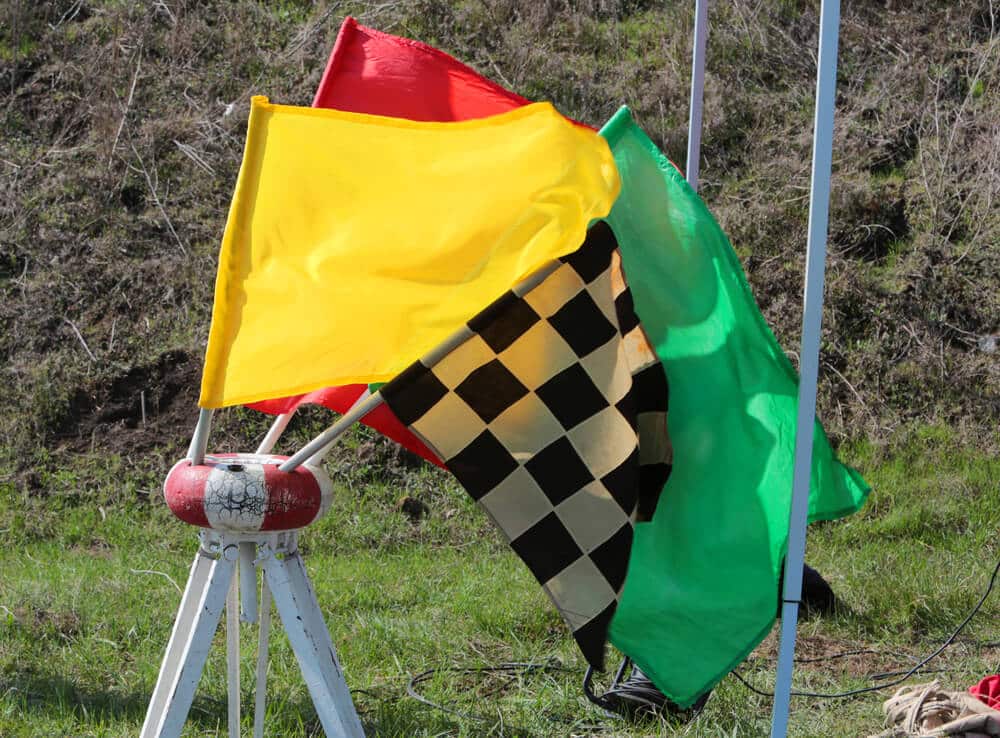Although the flags used in Formula One racing have been around for decades, their meanings and importance have only become more relevant with the increased safety considerations. A white flag is one of the most important symbols in Formula One.
The white flag is used to warn drivers of a slow-moving vehicle on the track or if there is any other miscellaneous vehicle present. Since drivers are unable to see ahead in a sequence of corners or blind ones, white flags help them stay alert and prepared for any potential obstacles that may be present.
Let’s take a better look at what it is and what the consequences are if drivers don’t take it seriously.
Table of Contents
Watch this video to learn more about the different flags in Formula One.
What does the White Flag mean?
In F1 races, a white flag is used as an indication of a slow-moving vehicle on the track. This slow-moving vehicle could either be a car with a problem or a service/safety car that is allowed to be on the track during races.
When a driver spots the white flag ahead of them, they are expected to lower their speed and be prepared to tackle a slow-moving vehicle.
Types of white flags
In Formula One, three types of white flags are used to indicate different situations:
- Static White Flag – Alerts drivers to the presence of a slow-moving vehicle in their path.
- Waved White Flag – Signals potential obstruction of slow-moving vehicles on the track.
- White Flag with SC Initials – Notifies drivers that a safety car is present on the track.
Apart from the races, the white flag is also used at the end of practice sessions. It allows drivers to slow down and stop on a grid slot in order to practice their launches before beginning a race.

Consequences of Ignoring a White Flag
Since ignoring white flags in Formula 1 (F1) puts drivers and other competitors at risk, there can be severe consequences. These include:
Safety risk
The first and most important consequence of ignoring white flags is a potential safety risk. As stated above, the white flag signals a slow-moving vehicle in front of you which must be taken seriously. If ignored, it could lead to an accident on the track, endangering drivers and other competitors.
Penalties
Not taking the white flag seriously can lead to penalties. Depending on the severity of the offence, some potential penalties could include a drive-through penalty, a stop-and-go penalty or even worse, i.e. disqualification from the race. This can severely affect the driver’s race results and overall standings in the championship.
Damaged reputation
Ignoring white flags can lead to a damaged reputation in the Formula One world. When fellow drivers, teams and fans witness an irresponsible act on the track, it casts a bad light on that driver’s character. It is important to note that this damage is not just limited to the driver but also reflects on their team as well.
Other Colored Flags in Formula One Racing
Apart from the white flag, there are other coloured flags used in Formula One racing. Let’s take a look at some of them:
Flag | Meaning |
Blue flags are waved in Formula One racing when a driver is being lapped by another travelling at a higher speed. | |
A black flag indicates disqualification in Formula One races, requiring the driver to return to their pits and end their race immediately. | |
It is used to signal the presence of a slow-moving vehicle such as a service/safety car or any miscellaneous vehicles on the track. | |
The chequered flag in Formula 1 indicates the end of a race, practice or qualifying session. | |
The red flag is used during Formula One races, qualifying sessions, and practice sessions to immediately stop the activity due to the danger posed to drivers or spectators. | |
Green flags signal that it’s safe to race as normal, without worrying about any obstructions on the track – this allows drivers to overtake and continue normal racing conditions. |
Frequently asked questions
What is the purpose of White in Formula One Racing?
When is the white flag waved in Formula One?
What are the consequences for a driver who ignores a white flag?
Conclusion
White flags in Formula One racing serve an important purpose – to alert drivers and other competitors of a slow-moving vehicle on the track. It is essential that drivers take this seriously, as ignoring white flags can lead to severe consequences such as penalties and a damaged reputation.
Furthermore, there are other coloured flags used in Formula One racing as outlined above. Understanding these flags and their significance is key to any F1 driver’s success. Next time you’re watching an F1 race, keep an eye out for the different flags and what they mean
Article sources
Learn more about Formula One
Want to learn more about F1? Then visit our Formula 1 glossary and dictionary.



